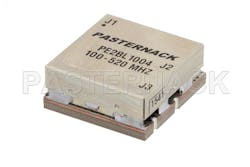Bits on Baluns – Part 2
Balun Performance Metrics
There are many different types of baluns and the type of balun used in microwave RF designs depends on the bandwidth required, the operating frequency, and the physical architecture of the design. Most baluns usually contain two or more insulated copper wires twisted together and wound around or inside a core, magnetic or non-magnetic. The following metrics are key in considering balun design, application, and performance.
Key specifications in determining the type of balun for a specific application include:
- > Frequency coverage
- > Phase Balance
- > Amplitude Balance
- > Common Mode Rejection Ratio
- > Impedance Ratio/Turns Ratio
- > Insertion and Return Loss
- > Balanced Port Isolation
- > DC/Ground Isolation
- > Group Delay Flatness
Phase Balance
An important performance criterion based on how close the balanced outputs are to having equal power and 180° phase, or balance, measured by how closely the inverted output is to 180° out of phase with the non-inverted output. The phase angle deviation from 180° is phase unbalance.
Amplitude Balance
This metric is determined by construction and line matching and is usually specified in dB. Amplitude balance indicates the match between output power magnitude, and the difference of these two magnitudes in dB is called amplitude unbalance. Generally, 0.1 dB improvement in amplitude balance will improve the common-mode rejection ratio (CMRR) by the same amount as a 1° improvement in phase balance.
Common Mode Rejection Ratio (CMRR)
When two identical signals with identical phase are injected into the balanced ports of the balun, they will be either reflected or absorbed. CMRR, specified in dB, is the amount of attenuation this signal will experience from the balanced to unbalanced port. The vectorial addition of the two signals determines the CMRR which is dependent on the amplitude and phase balance of the balun.
Impedance Ratio/Turns Ratio:
The ratio of the unbalanced impedance to the balanced impedance usually stated as 1:n. This differential impedance is between the balanced signal lines and is twice the impedance between the signal lines and ground. Turn ratio in a flux coupled balun transformer, is the ratio of primary windings to secondary windings; the square of the turns ratio with a 1:2 turn ratio gives a 1:4 impedance ratio. Flux coupled transformers can be used to design high impedance ratio baluns.
Insertion and Return Loss
The lower the differential insertion loss and higher the common mode return loss means more of the inserted signal power passes through the balun, and hence improved dynamic range, and less distortion of signals. In an ideal balun without isolation, the common mode signal would be perfectly reflected, with a return loss of 0 dB, while the differential signal would pass through completely with a return loss of -∞.
Balanced Port Isolation
The insertion loss from one balanced port to the other as specified in dB. Most baluns do not offer high isolation because the even mode is reflected instead of being properly terminated with a resistive load. An exception is the 180° hybrid circuit where the even mode is output to a port that can be resistively terminated.
